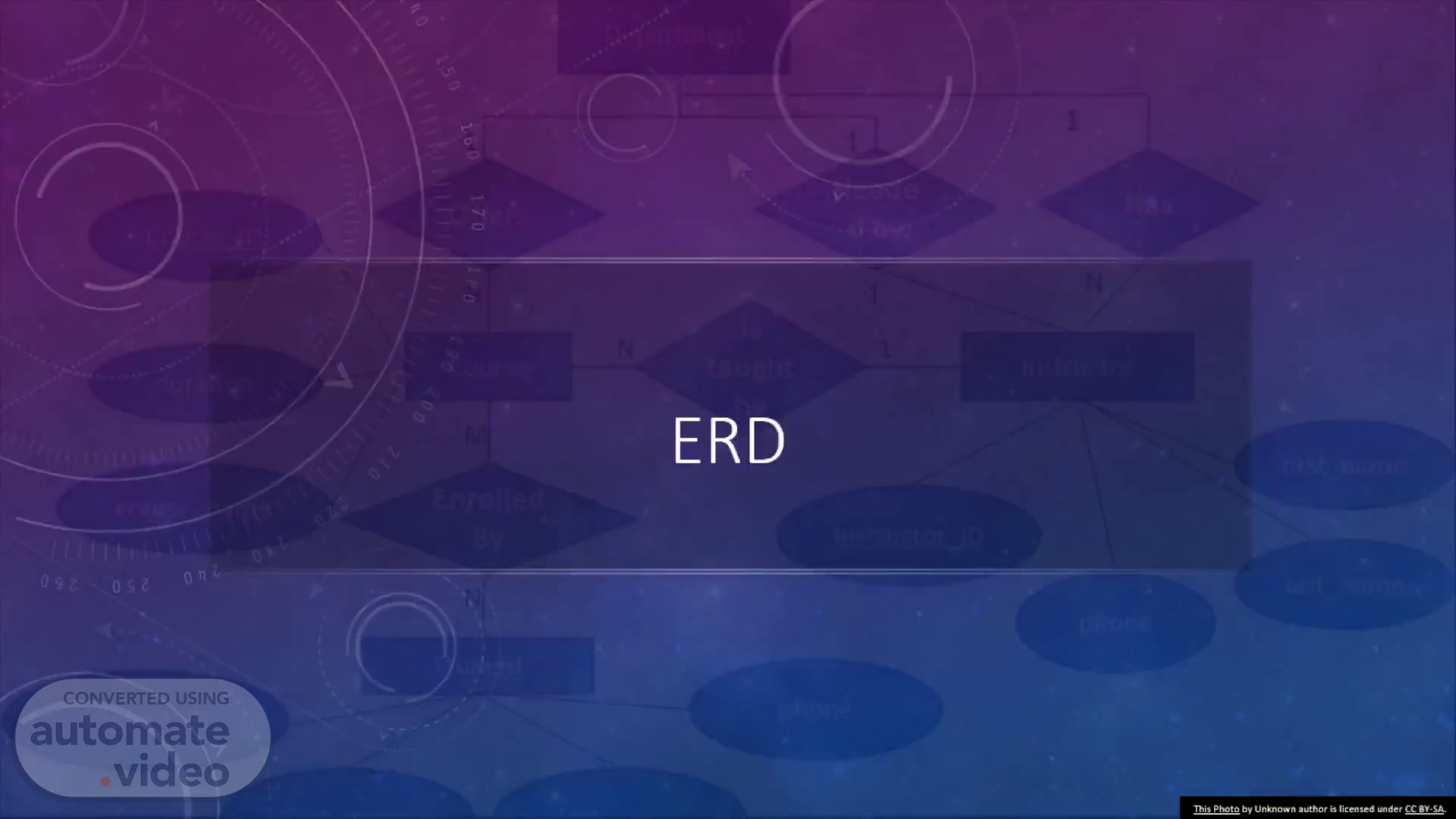Scene 1 (0s)
ERD. Entity Relationship Diagram. Diagram Description automatically generated.
Scene 2 (8s)
Introduction. White on blue abstract wintry background.
Scene 3 (16s)
Introduction. Entity-Relationship diagrams or ER diagrams are one of the database design tools that will be useful for you to understand. ER diagrams are pictures that represent how the data in a database are supposed to be connected or related to one another..
Scene 4 (31s)
How Entity-Relationship Diagrams Work. Top view of cubes connected with black lines.
Scene 5 (39s)
Representation. Normally, they look like a collection of ovals, rectangles and diamonds collected by lines. Clearly, Diagrams are not fine art. These diagrams can be very helpful for writing tricky queries in database..
Scene 6 (53s)
Entities. One big red drawing pin in front of many smaller black drawing pins.
Scene 7 (1m 2s)
Entities. The boxes in the Diagram are called Entities. 01 They represent categories of data your database will keep track of. 02 Each box is one category. 03 Eventually, each entity will probably become a table when the database is made. 04.
Scene 8 (1m 16s)
Entity Example. Autoradiogram on white paper.
Scene 9 (1m 24s)
Rules of Entity. Always in Rectangular form. Always be in capital letter. Always Singular..
Scene 10 (1m 33s)
STUDENT. COLLEGE.
Scene 11 (1m 39s)
Types of Entity.
Scene 12 (1m 46s)
Types of Entity. Strong Entity Weak Entity Associative Entity.
Scene 13 (1m 53s)
Strong Entity. Close-up of chain link.
Scene 14 (2m 1s)
Strong Entity. These shapes are independent from other entities, and are often called parent entities, since they will often have weak entities that depend on them. They will also have a primary key, distinguishing each occurrence of the entity..
Scene 15 (2m 15s)
Strong Entity. STUDENT.
Scene 16 (2m 21s)
Weak Entity.
Scene 17 (2m 27s)
Weak Entity. Weak entities depend on some other entity type. They don't have primary keys, and have no meaning in the diagram without their parent entity.
Scene 18 (2m 39s)
Weak Entity. APARTEMENT. WEAK ENTITY.
Scene 19 (2m 45s)
Weak Entity. BUILDING. APARTEMENT. BuildingID. NumberOfFloors.
Scene 20 (2m 55s)
Weak Entity. BUILDING. APARTEMENT. BuildingID. NumberOfFloors.
Scene 21 (3m 4s)
Weak Entity. BUILDING. APARTEMENT. BuildingID. NumberOfFloors.
Scene 22 (3m 13s)
Weak Entity. BUILDING. APARTEMENT. BuildingID. NumberOfFloors.
Scene 23 (3m 21s)
Weak Entity. BUILDING. APARTEMENT. BuildingID. NumberOfFloors.
Scene 24 (3m 29s)
Weak Entity. BUILDING. APARTEMENT. BuildingID. NumberOfFloors.
Scene 25 (3m 37s)
Associative entity. Hand with red strings.
Scene 26 (3m 45s)
Associative Entity. Associative entities relate the instances of several entity types. They also contain attributes specific to the relationship between those entity instances..
Scene 27 (3m 55s)
Associative Entity. ASSOCIATE ENTITY.
Scene 28 (4m 2s)
Attributes. Pile of rocks.
Scene 29 (4m 9s)
Attributes. The ovals in the Diagram are called Attributes. These represent aspects of each category or entity that will be recorded. Attributes will likely become the columns in the table that will be built around that entity. Each attribute in the Diagram has to be connected to at least one entity. Further, according to the rules of set theory, each attribute must be unique for that entity..
Scene 30 (4m 29s)
STUDENT. COLLEGE. StudentID. StudentName. CollegeStartDate.
Scene 31 (4m 38s)
Types of Attribute. Colourful rulers and protractors.
Scene 32 (4m 46s)
Types of Attribute. Simple Attributes Derived Attribute Composite Attribute Multivalued Attribute.
Scene 33 (4m 54s)
Simple Attributes.
Scene 34 (5m 0s)
Simple Attributes. Attributes are characteristics of an entity, a many-to-many relationship, or a one-to-one relationship.
Scene 35 (5m 10s)
Simple Attributes. StudentID.
Scene 36 (5m 16s)
Derived Attribute. A honeycomb glass surface.
Scene 37 (5m 23s)
Derived Attribute. Derived attributes are attributes whose value can be calculated from related attribute values..
Scene 38 (5m 32s)
Derived Attribute. Age. DateOfBirth.
Scene 39 (5m 39s)
MULTIVALUED ATTRIBUTE. A honeycomb glass surface.
Scene 40 (5m 46s)
Multivalued Attribute. Multivalued attributes are those that are can take on more than one value..
Scene 41 (5m 55s)
Multivalued Attribute. Phone Number.
Scene 42 (6m 2s)
Composite Attribute. A honeycomb glass surface.
Scene 43 (6m 9s)
Composite Attribute. Important measurement that can be completely reconstructed using other entities..
Scene 44 (6m 18s)
Composite Attribute. CLASSROOM. ( ClassRoomID ). NumberDesks.
Scene 45 (6m 26s)
Composite Attribute. CLASSROOM. ( ClassRoomID ). NumberDesk.
Scene 46 (6m 34s)
Composite Attribute. Building RoomNumber. CLASSROOM.
Scene 47 (6m 41s)
Multivalued Attribute VS Composite Attribute. A honeycomb glass surface.
Scene 48 (6m 49s)
Multivalued Attribute VS Composite Attribute. Phone Number.
Scene 49 (6m 58s)
Multivalued Attribute VS Composite Attribute. Phone Number.
Scene 50 (7m 9s)
Relationship. A honeycomb glass surface.
